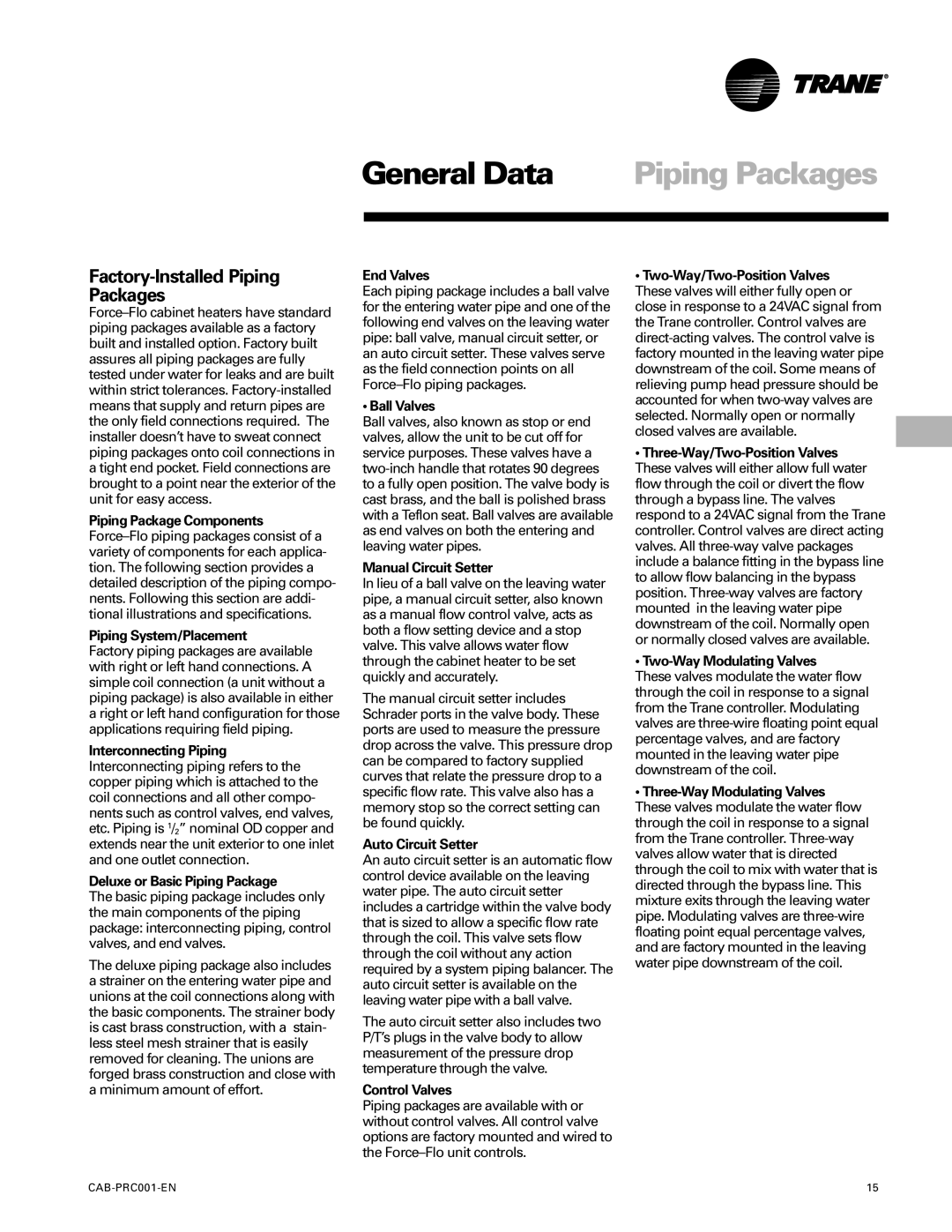Factory-Installed Piping Packages
Force–Flo cabinet heaters have standard piping packages available as a factory built and installed option. Factory built assures all piping packages are fully tested under water for leaks and are built within strict tolerances. Factory-installed means that supply and return pipes are the only field connections required. The installer doesn’t have to sweat connect piping packages onto coil connections in a tight end pocket. Field connections are brought to a point near the exterior of the unit for easy access.
Piping Package Components Force–Flo piping packages consist of a variety of components for each applica- tion. The following section provides a detailed description of the piping compo- nents. Following this section are addi- tional illustrations and specifications.
Piping System/Placement
Factory piping packages are available with right or left hand connections. A simple coil connection (a unit without a piping package) is also available in either a right or left hand configuration for those applications requiring field piping.
Interconnecting Piping Interconnecting piping refers to the copper piping which is attached to the coil connections and all other compo- nents such as control valves, end valves, etc. Piping is 1/2” nominal OD copper and extends near the unit exterior to one inlet and one outlet connection.
Deluxe or Basic Piping Package
The basic piping package includes only the main components of the piping package: interconnecting piping, control valves, and end valves.
The deluxe piping package also includes a strainer on the entering water pipe and unions at the coil connections along with the basic components. The strainer body is cast brass construction, with a stain- less steel mesh strainer that is easily removed for cleaning. The unions are forged brass construction and close with a minimum amount of effort.
End Valves
Each piping package includes a ball valve for the entering water pipe and one of the following end valves on the leaving water pipe: ball valve, manual circuit setter, or an auto circuit setter. These valves serve as the field connection points on all Force–Flo piping packages.
•Ball Valves
Ball valves, also known as stop or end valves, allow the unit to be cut off for service purposes. These valves have a two-inch handle that rotates 90 degrees to a fully open position. The valve body is cast brass, and the ball is polished brass with a Teflon seat. Ball valves are available as end valves on both the entering and leaving water pipes.
Manual Circuit Setter
In lieu of a ball valve on the leaving water pipe, a manual circuit setter, also known as a manual flow control valve, acts as both a flow setting device and a stop valve. This valve allows water flow through the cabinet heater to be set quickly and accurately.
The manual circuit setter includes Schrader ports in the valve body. These ports are used to measure the pressure drop across the valve. This pressure drop can be compared to factory supplied curves that relate the pressure drop to a specific flow rate. This valve also has a memory stop so the correct setting can be found quickly.
Auto Circuit Setter
An auto circuit setter is an automatic flow control device available on the leaving water pipe. The auto circuit setter includes a cartridge within the valve body that is sized to allow a specific flow rate through the coil. This valve sets flow through the coil without any action required by a system piping balancer. The auto circuit setter is available on the leaving water pipe with a ball valve.
The auto circuit setter also includes two P/T’s plugs in the valve body to allow measurement of the pressure drop temperature through the valve.
Control Valves
Piping packages are available with or without control valves. All control valve options are factory mounted and wired to the Force–Flo unit controls.
•Two-Way/Two-Position Valves These valves will either fully open or close in response to a 24VAC signal from the Trane controller. Control valves are direct-acting valves. The control valve is factory mounted in the leaving water pipe downstream of the coil. Some means of relieving pump head pressure should be accounted for when two-way valves are selected. Normally open or normally closed valves are available.
•Three-Way/Two-Position Valves
These valves will either allow full water flow through the coil or divert the flow through a bypass line. The valves respond to a 24VAC signal from the Trane controller. Control valves are direct acting valves. All three-way valve packages include a balance fitting in the bypass line to allow flow balancing in the bypass position. Three-way valves are factory mounted in the leaving water pipe downstream of the coil. Normally open or normally closed valves are available.
•Two-Way Modulating Valves
These valves modulate the water flow through the coil in response to a signal from the Trane controller. Modulating valves are three-wire floating point equal percentage valves, and are factory mounted in the leaving water pipe downstream of the coil.
•Three-Way Modulating Valves These valves modulate the water flow through the coil in response to a signal from the Trane controller. Three-way valves allow water that is directed through the coil to mix with water that is directed through the bypass line. This mixture exits through the leaving water pipe. Modulating valves are three-wire floating point equal percentage valves, and are factory mounted in the leaving water pipe downstream of the coil.

